
Acanthaceae is a family of dicotyledonous flowering plants containing almost 250 genera and about 2500 species. Most are tropical herbs, shrubs, or twining vines; some are epiphytes. Only a few species are distributed in temperate regions. The four main centres of distribution are Indonesia and Malaysia, Africa, Brazil, and Central America. Representatives of the family can be found in nearly every habitat, including dense or open forests, scrublands, wet fields and valleys, sea coast and marine areas, swamps, and mangrove forests.
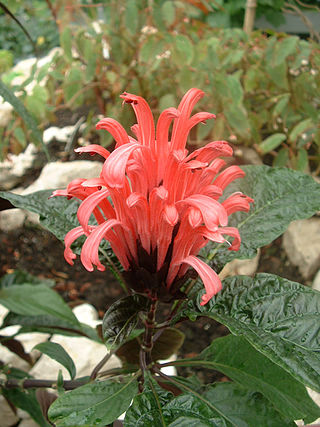
Justicia is a genus of flowering plants in the family Acanthaceae. It is the largest genus within the family, with over 900 accepted species. They are native to tropical to warm temperate regions of the Americas, India, and Africa. The genus serves as host to many butterfly species, such as Anartia fatima. Common names include water-willow and shrimp plant, the latter from the inflorescences, which resemble a shrimp in some species. The generic name honours Scottish horticulturist James Justice (1698–1763). They are closely related to Pachystachys.

Dicliptera is a genus of flowering plants in the bear's breeches family, Acanthaceae. It includes 223 species native to the tropics and subtropics worldwide. Well-known synonyms include Peristrophe and Dactylostegium.

Hygrophila, commonly known as swampweeds, is a genus of flowering plants in the acanthus family, Acanthaceae. There are about 80 to 100 species, of which many are aquatic plants. The genus is distributed across the tropical and subtropical world. It is one of only two genera in its family that contains aquatic plants, the other being Justicia. The genus is treated in the tribe Hygrophileae, which is noted as being in need of revision at the genus level, meaning the current taxonomic boundaries of Hygrophila are likely to change in the future.

Lepidagathis is a genus of flowering plants in the family Acanthaceae. It includes 151 species native to the tropics of the Americas, sub-Saharan Africa, south and southeast Asia, southern China, Malesia, and New Guinea.

Blepharis is a genus of plant in family Acanthaceae. It contains around 128 species found in seasonally dry to arid habitats from Africa through Arabia to Southeast Asia. In section Acanthodium, there are 13–15 species that use the C4 carbon fixation pathway. Phylogenetic analysis suggests that this pathway evolved up to three times independently in the genus over the last five million years.

Brachystephanus is a genus of flowering plants in the family Acanthaceae. It includes 21 species native to tropical Africa and Madagascar.

Neuracanthus is a genus of flowering plants in the family Acanthaceae. It includes 32 species native to tropical Africa, Madagascar, the Arabian Peninsula, Indian subcontinent, and Indochina.

Pseuderanthemum is a genus of plants in family Acanthaceae with a pantropical distribution.

Rhinacanthus is a genus of plants in the family Acanthaceae. It includes 26 species native to tropical Africa and Asia, ranging across sub-Saharan Africa to Madagascar, the Indian subcontinent, Indochina, south-central China, Peninsular Malaysia, and the Philippines.
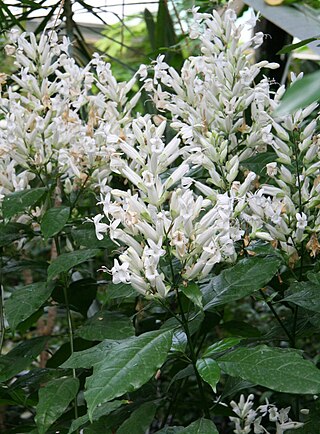
Whitfieldia is a genus of flowering plants in the family Acanthaceae. It includes 13 species of erect or scrambling shrubs native to tropical Africa. The greatest species diversity is in the Guineo-Congolian rainforests of western and central Africa.

Mimulopsis is a genus in the flowering plant family Acanthaceae with about 20 species native to tropical Africa and Madagascar.
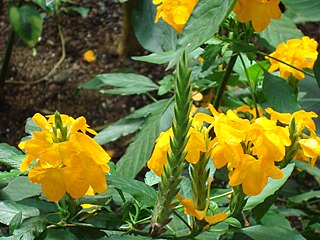
Crossandra is a genus of plants in the family Acanthaceae, comprising 54 species that occur in Africa, Madagascar, Arabia and the Indian subcontinent. Some species, especially Crossandra infundibuliformis, are cultivated for their brightly colored flowers.
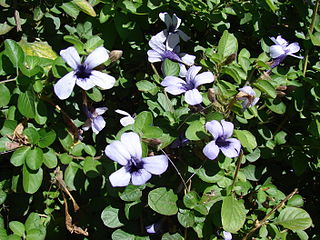
Dyschoriste is a genus of flowering plants in the family Acanthaceae. It includes 98 species native to the tropics and subtropics of the Americas, sub-Saharan Africa, and southern Asia. Members of the genus are commonly known as snakeherb.
Metarungia galpinii is a species of flowering plant in the family Acanthaceae of dicotyledonous flowering plants. It is a shrub endemic to the Eastern Cape Province of South Africa. It is the sole species in genus Metarungia.

Ecbolium is a genus of flowering plants in the family Acanthaceae. It includes 26 species native to southern and eastern Africa, the Arabian Peninsula, Indian subcontinent, and Myanmar.
Stenandriopsis is a genus of flowering plants belonging to the family Acanthaceae. It includes 20 species native to tropical Africa and Madagascar. Molecular phylogenies have placed the Old World Stenandriopsis apart from New World Stenandrium, and the genus is accepted in a classification of the family Acanthaceae published in 2022.
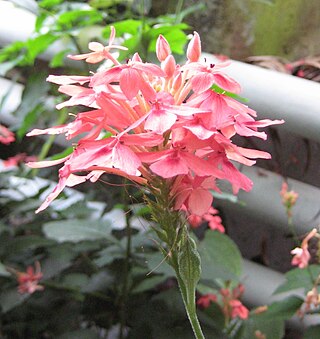
Ruspolia is a genus of flowering plants belonging to the family Acanthaceae.
















